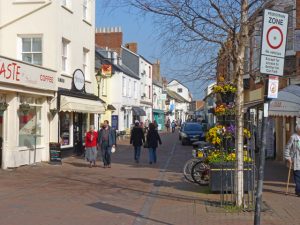“In the coming weeks and months, clear guidance from the government on using transport safely and efforts to build the infrastructure for walkers, runners and cyclists will be critical.”
.
 We need to be thinking about our public spaces:
We need to be thinking about our public spaces:
Redesigning our spaces after the coronavirus
Redesigning our spaces after the coronavirus: part two
.
And some spaces will be easier to redesign than others…
Old Fore Street, Sidmouth © Mike Smith cc-by-sa/2.0 :: Geograph …
.
Meanwhile, the government has been providing guidance on how to manage public spaces:
The question remains, however, whether this guidance will be enough:
How major cities are trying to keep people walking and cycling after the lockdown
Research suggests that 58% of car journeys in the UK are shorter than 5km, so walking or cycling could be the main alternative for many city dwellers. That’s how people in Denmark got around while still maintaining social distancing. More Danes are cycling than ever, but a cycling culture had already existed in the country for a long time.
Cultural changes can take a long time to take root. A lasting transformation of city streets will need careful planning and buy-in from the public. The enjoyment that many have taken from quieter streets during their daily exercise could produce a cultural shift towards more active travel and less car use in the UK. But in the coming weeks and months, clear guidance from the government on using transport safely and efforts to build the infrastructure for walkers, runners and cyclists will be critical to making it stick. Reshaping cities to allow people more space to walk and cycle will help lay the ground for permanent change.
How major cities are trying to keep people walking and cycling after the lockdown | weforum.org